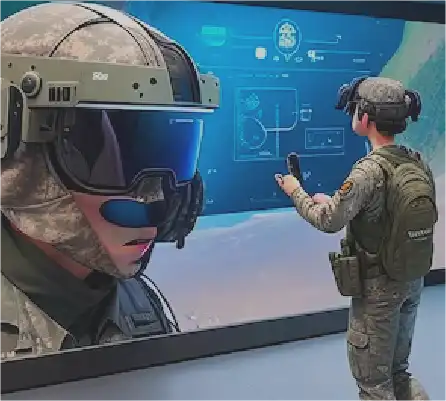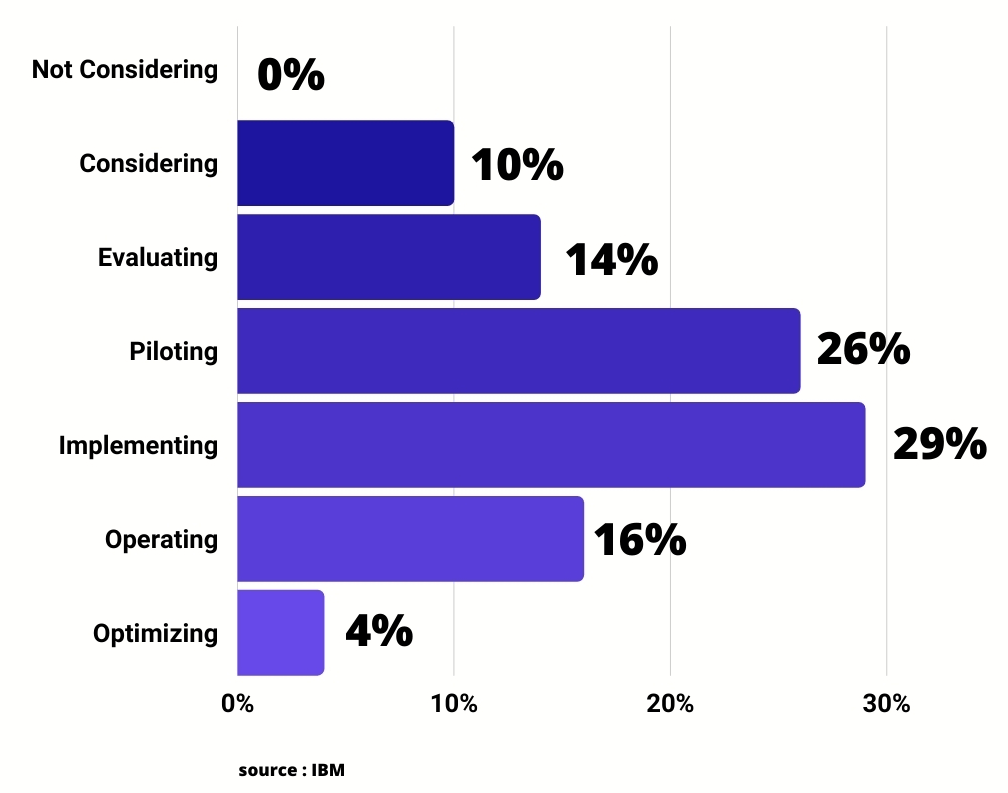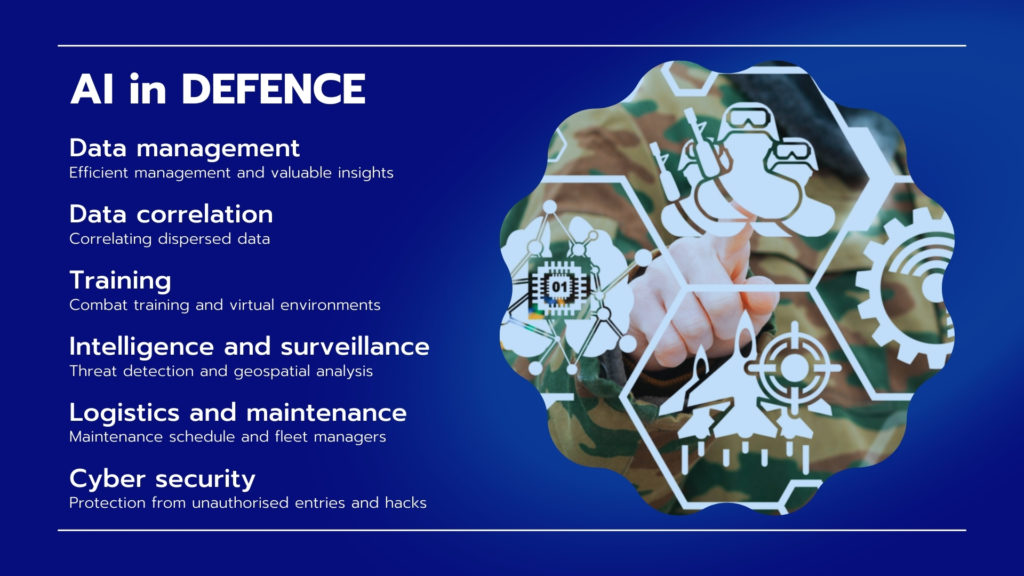Project Management
AI in Defense – A friend or a foe?
- Surya Vamsi
- August 16, 2021

The rising competition globally is not only in commercial and technological terms but also in the key strategies and fundamentals of the nations. Defense is one such important aspect that is laid stress upon to ensure better security. Any nation must maintain its guard up against all the existing as well as potential risks, threats, etc. to ensure a prosperous future. To achieve this, AI can potentially assist nations by enabling stronger foundations through automated and efficient data management.
AI with its capabilities to lead the nations into a path of sustainable development, can also assist the nation in its walk towards a concrete defense structure.
AI-equipped defense technologies can handle volumes of data with better efficiency free from potential human errors and thereby provide strong support to the nation’s pillars of defense.
Statistics
IBM recently stated that around 73% of the defense leaders believe that AI will be imperative for their organizational strategies in the next few years.

In a report published, IBM also stated that around 49% of the defense organizations have already implemented AI for optimizing as well as operational purposes.
Artificial Intelligence in Nation’s defense
AI has few potentially significant capabilities which when employed in the defense can improve the overall strengths of the nation. A few of the use cases of AI in defense technology are-

Data Management Under Concrete Time Constraints
One of the crucial requirements of any defense wing is to streamline cumulonimbus volumes of data within short spans of time. Teams that leverage the advantages of AI can adequately handle such situations without the need for a data scientist to analyze the data and generate valuable insights. Furthermore, ML can help the AI tech to adapt to the previous experiences thereby generating results much quicker over time.
Correlation of Dispersed Data
Defense organizations receive Intel and statics from not just one, but numerous sources and platforms. This information is often clustered and the data interpreters spend valuable man-hours trying to correlate and organize this information manually. AI can alleviate this problem with the use of algorithms and data structures to organize the information at a much quicker pace and with minimal manual requirements.
Training and sensor
AI can detect accurate target locations in complex combat situations assisting the soldiers to progress accordingly. AI is the key technology involved in various sensor recognition systems which detect incoming threats as well as potential risks in the terrains. United States Naval and Army wings have already integrated similar sensor simulation programs into their organizations.
Furthermore, Defence organizations worldwide are also employing VR ad AR technology to create complex and realistic combat environments to prepare the soldiers for the actual battle experience with no actual risks involved.
Intelligence & Surveillance
Recently Pentagon has initiated Project Maven, which aims to integrate AI and computer vision that can skim through the footage from unmanned aerial vehicles to collect information over hostile areas. This would prevent the numerous hours spent by the video analysts from shifting from footage to footage.
Similar attributes of AI like geospatial analysis etc can be used to gather valuable pieces of information from radars etc. The computer vision can then detect the presence of any unauthorized presence or an approaching threat.
Logistics & Maintenance
AI has potential applications in military logistics. From the maintenances of air crafts and vehicles to the scheduling of fleet-based operations, AI can be employed to automate the process and reduce the overall time and effort required.
Air Force worldwide is testing the potential of AI to tailor maintenance schedules and requirements for individual air crafts. This will minimize both efforts and time required to repair an aircraft after a complete breakdown.
CyberSecurity
Confidential information on secure networks is the foundation of any defense network. Only authorized individuals have the liberty to access these networks and information. A hack into these systems can prove fatal not just to the organization, but the entire region.
Systems equipped with AI can detect these cyber-attacks and prevent further infiltration. Furthermore, AI can also predict the pattern of these hacks and create a robust firewall to prevent any further attacks.
Autonomous and Semi-autonomous vehicles
AI integrated autonomous and semi-autonomous vehicles are significantly better at detecting obstacles, plan navigation, and also communicate with other vehicles. Considering these advantages, Defence services are working to incorporate AI into fighter jets, ground vehicles, naval vehicles, etc.
Arms and Ammunition
Present-day arsenals of the Defence are completely filled with an advanced set of weapons. These weapons are capable of more accurate targeting of a higher range. The AI-embedded weapons like missiles etc have the capability to self-navigate towards the target area. These weapons need no human interaction or direction.
LAWS- Lethal Autonomous Weapon System uses sensors and algorithms to automatically target the enemy and engage in action. Although still in the research phase, LAWS once integrated into the Defence can remove any human involvement. This will not only reduce the overall resource requirements but also the number of human casualties in warzones.
AI in Defense – Where does India Stand?
India since the past few years has been an active explorer of similar opportunities to strengthen its Defence wings. In order to employ the power-ups and strengths offered by AI India has taken up major initiatives through various organizations. Few of them are-
– The Ministry of Defence has constituted a task force for the Strategic implementation of Artificial Intelligence in defense. The aim is to analyze and submit a verified report on the existing state of AI in defense. This task force also recommends institutional guidelines to integrate AI into the organization.

AI in Indian Defence
– In February 2019, the Government of India has constituted a High-Level Defence AI Council (DAIC) to provide an overall strategic direction towards intensive implementation of AI into defense. The DAIC will also enable strategic partnership with industries for the achievement of said objectives and guide the defense in recommendations concerning the adoption of new technologies and startups.
– Center for Artificial Intelligence(CAIR) has sanctioned a project to develop Artificial Intelligence based solutions to augment the intelligence capabilities and analytics of the defense wings.
Challenges
Although AI has potential offerings to defense, we need to address few crucial challenges before leveraging them. The ethical dilemma to depend on AI for the nation’s defense is one such major challenge. With this major factor oscillating towards various extremes, policy-makers need to agree on a unanimous standing before the integration.
Few other challenges include the capability of the policy-makers to understand the ultimate goal to be achieved through AI, the availability of the required skillset and infrastructure in the defense organizations to facilitate high-end technologies, the dependency on the private sector for the provision of required infrastructure thereby compromising on the concrete singularity of nation’s defense.
Through efficient decisions and optimizations, AI can concrete the defense structure of the nations. The stronger the defense, the stronger the nation.
Email Newsletter
get updates & more
